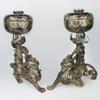Pilgrimage: Ink and White Space
- June 09, 2017 17:02
A little over three years ago, I attended an ekphrastic workshop at the Smithsonian in Washington DC. It was organized by Letras Latinas and inspired by the exhibit, “Our America: The Latino Presence in American Art.” The exhibit and workshop traveled to other cities, letting the poets study, view, and then write poems inspired by the art, which went on to be published in several literary magazines. Fred Arroyo’s “Patio Dreams” is a product of this workshop and the collaborative spirit that brought together different communities and writers across the country. Ever since then, I have been noticing the way visual art and words influence each other, a realization that this connection has been there all along. Inspiration emerges in those moments when we slow down to appreciate our galleries, train cars tagged with vibrant graffiti, or sculptures that eclipse us in size. Some works in this issue are direct ekphrastic poems inspired by wonderful pieces of art, such as Danielle Beazer Dubrasky’s “What Is Visible” and Lisa Mullenneaux’s “Bellini’s St. Francis in Ecstasy”. I encourage you to do a quick search online to find the art that inspired them as you read the poems.
The link to “Ink & White Space” does not begin or end with ekphrasis. Writers play on the page and take on countless forms, where the words, stanzas, sentences, and paragraphs occupy the page and how the remaining, the supposed “blank spaces,” serve the work. The shape of the writing is a field. It is the space occupied by someone riding in a Greyhound, the loss of memory to Alzheimer's, objects crumbling to dust in obscurity, and growing up a tomboy and struggling to figure what is expected from you.
The issue’s theme was inspired by the art by Dmitry Borshch, with admiration for the deliberate lines and how strongly they contrast with white, displaying patterns and symmetry in nature. His art lets us contemplate the beautiful world we do not always appreciate. In an artist statement, he writes:
I distinguish between narrow and broad motivations, which may not always interact. The second type of motivation is a desire to speak as an artist—silence, especially artistic, is painful. The first involves being challenged by narrower, often technical problems— arranging successfully a group or one-figure portrait, succeeding as a landscapist, still-life painter.
He preserves landscapes and still-life in the “precision of the ink line.” Like Borshch, we celebrate experiments on the page. Our way of exploring includes poems and prose of all shapes, the side-by- side translation of the poet Héctor Caretto by Octavio Quintanilla, poem diagrams by Jessy Randall, and our first ever dramatic play with Idris Goodwin’s “Black Flag,” which hangs the Confederate Flag in a dorm and stirring the tension of two college roommates.
We use ink and white space to guide us toward the future and in the ways we preserve our histories as witnesses and contributors. It can be the clothes we wear during critical times, the tattoos we use to celebrate our body, the pigment of our skin, or all else that goes deeper. Just as crucial as ink and white space to communicate, we need to use them to find moments where our lives converge.
Juan Morales
Pueblo, CO
March 2017





















